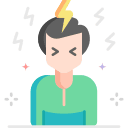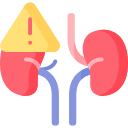ZOTEPINE
THERAPEUTICS
Class
- Neuroscience-based Nomenclature: dopamine, serotonin receptor antagonist (DS-RAn)
- Atypical antipsychotic (serotonin– dopamine antagonist)
ZOTEPINE commonly prescribed for
(Bold for FDA approved)
 How ZOTEPINE works
How ZOTEPINE works
• Blocks dopamine 2 receptors, reducing positive symptoms of psychosis
• Blocks serotonin 2A receptors, causing enhancement of dopamine release in certain brain regions and thus reducing motor side effects and possibly improving cognitive and affective symptoms
• Interactions at a myriad of other neurotransmitter receptors may contribute to zotepine’s efficacy
• Specifically inhibits norepinephrine uptake
How long until ZOTEPINE works
• Psychotic and manic symptoms can improve within 1 week, but it may take several weeks for full effect on behavior as well as on cognition and affective stabilization
• Classically recommended to wait at least 4–6 weeks to determine efficacy of drug, but in practice some patients require up to 16–20 weeks to show a good response, especially on cognitive symptoms
SIDE EFFECTS
 Notable Side Effects
Notable Side Effects
• Atypical antipsychotics may increase the risk for diabetes and dyslipidemia, although the specific risks associated with zotepine are unknown
• Agitation, anxiety, depression, asthenia, headache, insomnia, sedation, hypo/ hyperthermia
• Constipation, dry mouth, dyspepsia, weight gain
• Tachycardia, hypotension, sweating, blurred vision
• Tardive dyskinesia
• Risk of potentially irreversible involuntary dyskinetic movements may increase with cumulative dose and treatment duration
• Dose-related hyperprolactinemia
 Life Threatening Side Effects
Life Threatening Side Effects
• Rare neuroleptic malignant syndrome may cause hyperpyrexia, muscle rigidity, delirium, and autonomic instability with elevated creatine phosphokinase, myoglobinuria (rhabdomyolysis), and acute renal failure
• Rare seizures (risk increases with dose, especially over 300 mg/day)
• Blood dyscrasias
• Dose-dependent QTc prolongation
• As a class, antipsychotics are associated with an increased risk of death and cerebrovascular events in elderly patients with dementia; not approved for treatment of dementia-related psychosis
weight gain

common
sedation

common
What to do about ZOTEPINE side effects
• Wait
• Wait
• Wait
• For drug-induced parkinsonism, add an anticholinergic agent
• Beta blockers, benzodiazepines, or serotonin 2A antagonists (e.g., mirtazapine, cyproheptadine) may reduce akathisia
• Take more of the dose at bedtime to help reduce daytime sedation
• Weight loss, exercise programs, and medical management for high BMIs, diabetes, dyslipidemia
• Metformin may help prevent or reverse antipsychotic-induced weight gain
• Reduce the dose
• Switch to a first-line atypical antipsychotic
DOSING AND USE
usual dosage range
• 75–300 mg/day in 3 divided doses
 Dosage Forms
Dosage Forms
• Tablet 25 mg, 50 mg, 100 mg
long term use
• Can be used to delay relapse in long-term treatment of schizophrenia
• Should periodically reevaluate long-term usefulness in individual patients, but treatment may need to continue for many years
habit forming
• No
SPECIAL POPULATIONS
 Renal Impairment
Renal Impairment
• Recommended starting dose 25 mg twice a day; recommended maximum dose generally 75 mg twice a day
 Hepatic Impairment
Hepatic Impairment
• Recommended starting dose 25 mg twice a day; recommended maximum dose generally 75 mg twice a day
• May require weekly monitoring of liver function during the first few months of treatment
 Cardiac Impairment
Cardiac Impairment
• Drug should be used with caution
• Zotepine produces a dose-dependent prolongation of QTc interval, which may be enhanced by the existence of bradycardia, hypokalemia, congenital or acquired long QTc interval, which should be evaluated prior to administering zotepine
• Use with caution if treating concomitantly with a medication likely to produce prolonged bradycardia, hypokalemia, slowing of intracardiac conduction, or prolongation of the QTc interval
• Avoid zotepine in patients with a known history of QTc prolongation, recent acute myocardial infarction, and uncompensated heart failure
 Elderly
Elderly
• Recommended starting dose 25 mg twice a day; recommended maximum dose generally 75 mg twice a day
• Although atypical antipsychotics are commonly used for behavioral disturbances in dementia, no agent has been approved for treatment of elderly patients with behavioral symptoms of dementia such as agitation
• Elderly patients with dementia-related psychosis treated with atypical antipsychotics are at an increased risk of death compared to placebo, and also have an increased risk of cerebrovascular events
 Children and Adolescents
Children and Adolescents
• Not recommended for use in children under age 18
 Pregnancy
Pregnancy
• Insufficient data in humans to determine risk
• There is a risk of abnormal muscle movements and withdrawal symptomsin newborns whose mothers took an antipsychotic during the third trimester; symptoms may include agitation, abnormally increased or decreased muscle tone, tremor, sleepiness, severe difficulty breathing, and difficulty feeding
• Zotepine is not recommended during pregnancy
 Breast Feeding
Breast Feeding
• Zotepine is not recommended during breast feeding
• Immediate postpartum period is a highrisk time for relapse of psychosis, so may consider treatment with another antipsychotic
Based on data Published online by Cambridge University Press
Compiled by Dr. Jash Ajmera